power steering fluid ASTON MARTIN V8 VANTAGE 2010 Workshop Manual
[x] Cancel search | Manufacturer: ASTON MARTIN, Model Year: 2010, Model line: V8 VANTAGE, Model: ASTON MARTIN V8 VANTAGE 2010Pages: 947, PDF Size: 43.21 MB
Page 602 of 947
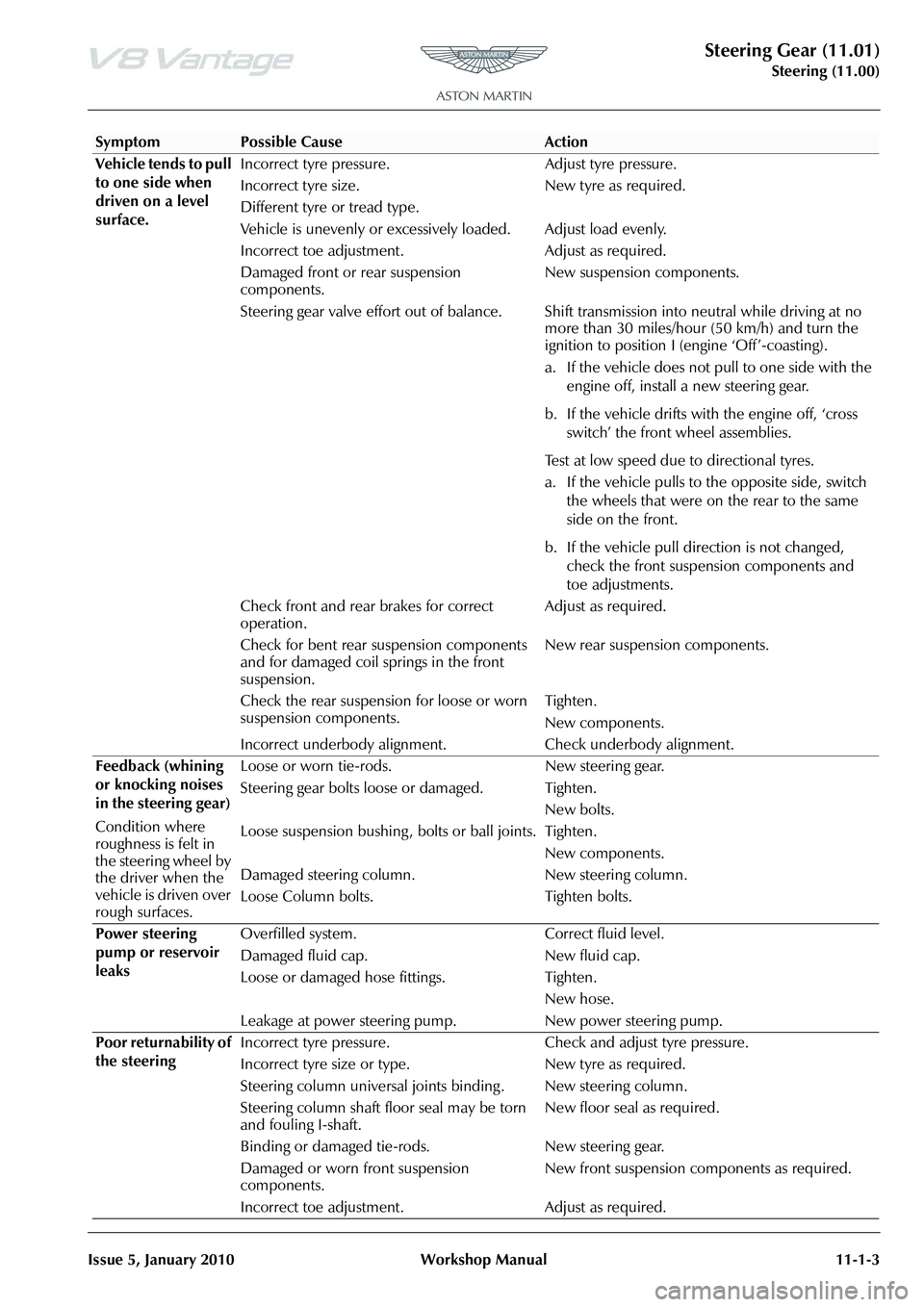
Steering Gear (11.01)
Steering (11.00)
Issue 5, January 2010 Workshop Manual 11-1-3
Vehicle tends to pull
to one side when
driven on a level
surface. Incorrect tyre pressure. Adjust tyre pressure.
Incorrect tyre size.
Different tyre or tread type.
New tyre as required.
Vehicle is unevenly or excessively loaded. Adjust load evenly.
Incorrect toe adjustment. Adjust as required.
Damaged front or rear suspension
components. New suspension components.
Steering gear valve effort out of balance. Shift transmission into neutral while driving at no more than 30 miles/hour (50 km/h) and turn the
ignition to position I (engine ‘Off’-coasting).
a. If the vehicle does not pull to one side with the
engine off, install a new steering gear.
b. If the vehicle drifts with the engine off, ‘cross switch’ the front wheel assemblies.
Test at low speed due to directional tyres.
a. If the vehicle pulls to the opposite side, switch the wheels that were on the rear to the same
side on the front.
b. If the vehicle pull direction is not changed, check the front suspension components and
toe adjustments.
Check front and rear brakes for correct
operation. Adjust as required.
Check for bent rear suspension components
and for damaged coil springs in the front
suspension. New rear suspension components.
Check the rear suspension for loose or worn
suspension components. Tighten.
New components.
Incorrect underbody alignment. Check underbody alignment.
Feedback (whining
or knocking noises
in the steering gear)
Condition where
roughness is felt in
the steering wheel by
the driver when the
vehicle is driven over
rough surfaces. Loose or worn tie-rods. New steering gear.
Steering gear bolts loose or damaged. Tighten.
New bolts.
Loose suspension bushing , bolts or ball joints. Tighten.
New components.
Damaged steering column.
Loose Column bolts. New steering column.
Tighten bolts.
Power steering
pump or reservoir
leaks Overfilled system. Correct fluid level.
Damaged fluid cap. New fluid cap.
Loose or damaged hose fittings. Tighten.
New hose.
Leakage at power steering pump. New power steering pump.
Poor returnability of
the steering Incorrect tyre pressure. Check
and adjust tyre pressure.
Incorrect tyre size or ty pe. New tyre as required.
Steering column universal joints binding . New steering column.
Steering column shaft floor seal may be torn
and fouling I-shaft. New floor seal as required.
Binding or damaged tie-rods. New steering gear.
Damaged or worn front suspension
components. New front suspension components as required.
Incorrect toe adjustment. Adjust as required.
SymptomPossible CauseAction
Page 603 of 947
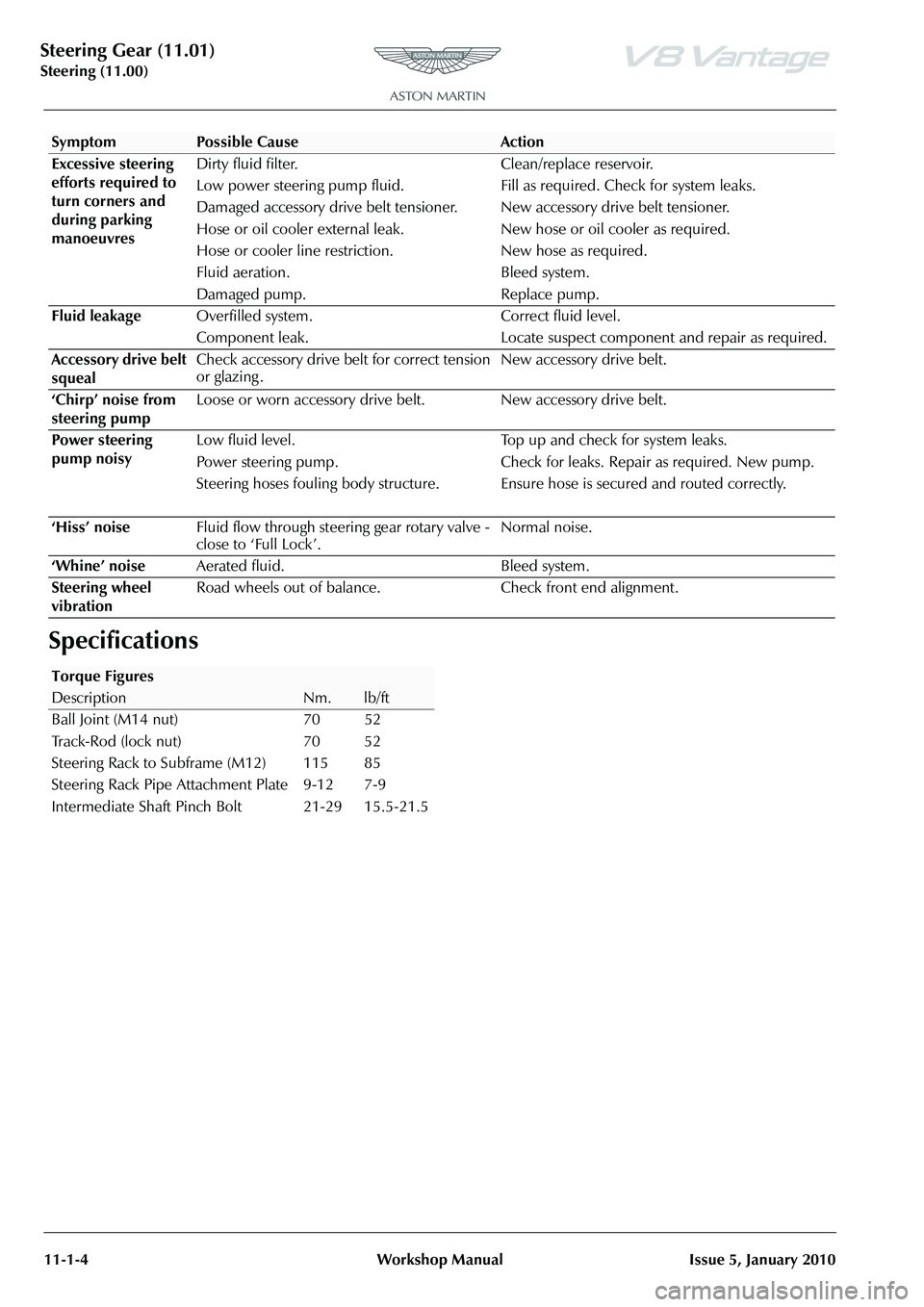
Steering Gear (11.01)
Steering (11.00)11-1-4 Workshop Manual Issue 5, January 2010
Specifications
Excessive steering
efforts required to
turn corners and
during parking
manoeuvres Dirty fluid filter.
Low power steering pump fluid.
Clean/replace reservoir.
Fill as required. Check for system leaks.
Damaged accessory drive belt tensioner. New accessory drive belt tensioner.
Hose or oil cooler external leak. New hose or oil cooler as required.
Hose or cooler line restriction. New hose as required.
Fluid aeration.
Damaged pump. Bleed system.
Replace pump.
Fluid leakage Overfilled system. Correct fluid level.
Component leak. Locate suspect component and repair as required.
Accessory drive belt
squeal Check accessory drive belt for correct tension
or glazing .
New accessory drive belt.
‘Chirp’ noise from
steering pump Loose or worn accessory drive belt. New accessory drive belt.
Power steering
pump noisy Low fluid level. Top up and check for system leaks.
Power steering pump.
Steering hoses fouling body structure. Check for leaks. Repair
as required. New pump.
Ensure hose is secured and routed correctly.
‘Hiss’ noise Fluid flow through steering gear rotary valve -
close to ‘Full Lock’. Normal noise.
‘Whine’ noise Aerated fluid. Bleed system.
Steering wheel
vibration Road wheels out of balance. Check front end alignment.
SymptomPossible CauseAction
Torque Figures
DescriptionNm.lb/ft
Ball Joint (M14 nut) 70 52
Track-Rod (lock nut) 70 52
Steering Rack to Subframe (M12) 115 85
Steering Rack Pipe Attachment Plate 9-12 7-9
Intermediate Shaft Pinch Bolt 21-29 15.5-21.5
Page 604 of 947
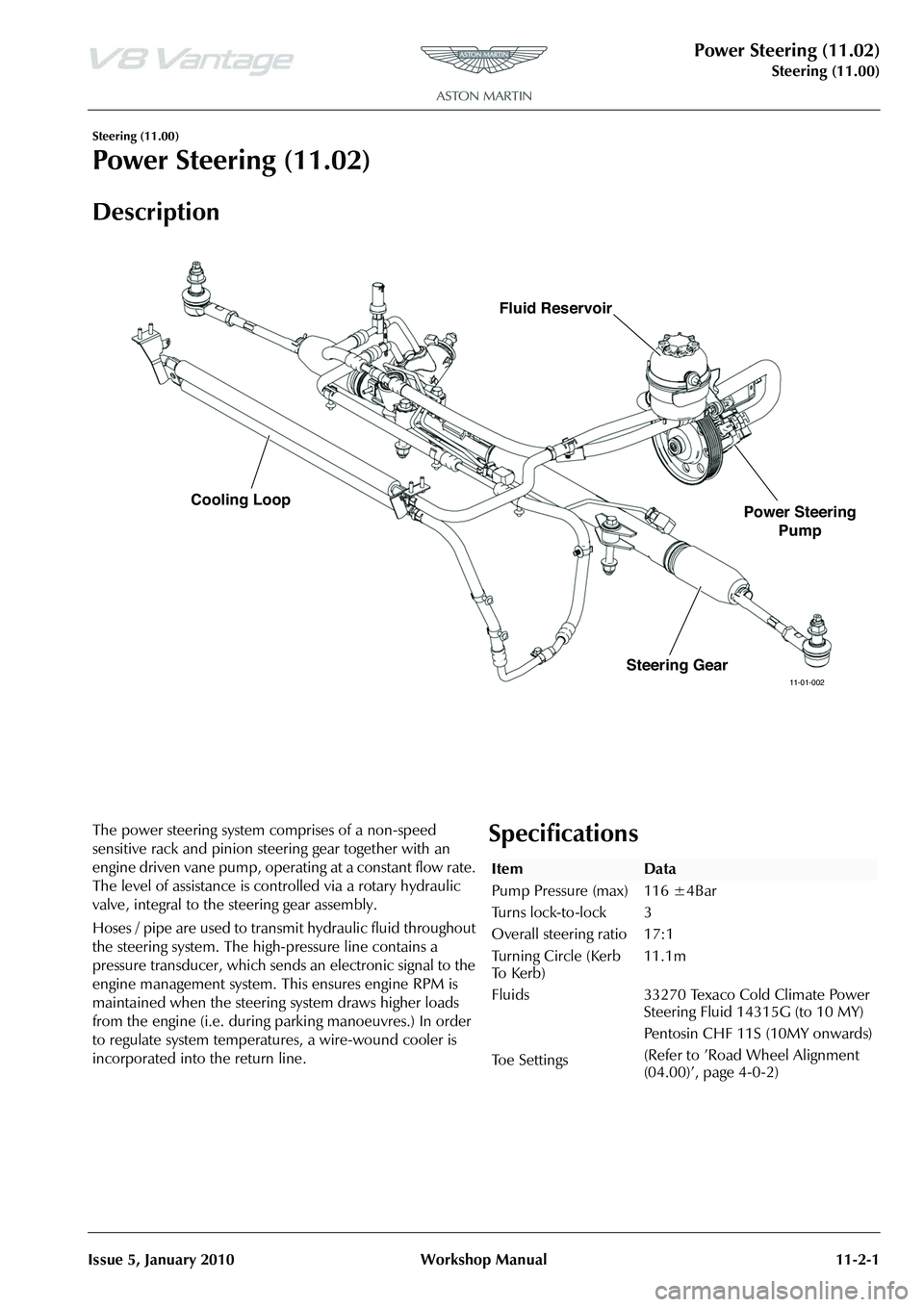
Power Steering (11.02)
Steering (11.00)
Issue 5, January 2010 Workshop Manual 11-2-1
Steering (11.00)
Power Steering (11.02)
Description
The power steering system comprises of a non-speed
sensitive rack and pinion steering gear together with an
engine driven vane pump, operating at a constant flow rate.
The level of assistance is co ntrolled via a rotary hydraulic
valve, integral to the steering gear assembly.
Hoses / pipe are used to transm it hydraulic fluid throughout
the steering system. The high -pressure line contains a
pressure transducer, which sends an electronic signal to the
engine management system. This ensures engine RPM is
maintained when the steering system draws higher loads
from the engine (i.e. during parking manoeuvres.) In order
to regulate system temperatures, a wire-wound cooler is
incorporated into the return line.Specifications
11-01-002Steering Gear
Cooling Loop
Power Steering
Pump
Fluid Reservoir
ItemData
Pump Pressure (max)
Turns lock-to-lock
Overall steering ratio
Turning Circle (Kerb
To K e r b )
Fluids
Toe Settings 116 ±4Bar
3
17:1
11.1m
33270 Texaco Cold Climate Power
Steering Fluid 14315G (to 10 MY)
Pentosin CHF 11S (10MY onwards)
(Refer to ’Road Wheel Alignment
(04.00)
Page 605 of 947
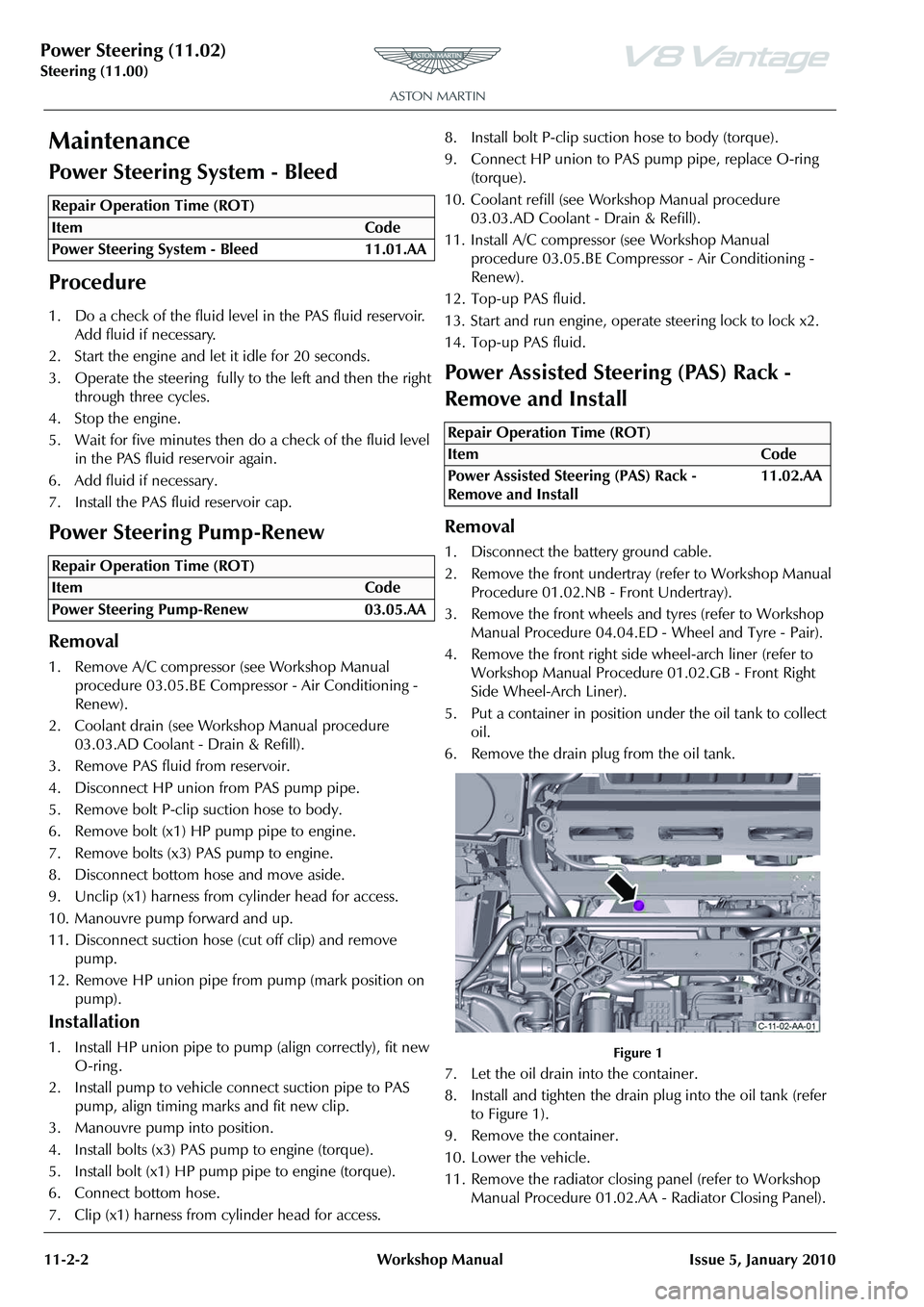
Power Steering (11.02)
Steering (11.00)11-2-2 Workshop Manual Issue 5, January 2010
Maintenance
Power Steering System - Bleed
Procedure
1. Do a check of the fluid level in the PAS fluid reservoir. Add fluid if necessary.
2. Start the engine and let it idle for 20 seconds.
3. Operate the steering fully to the left and then the right through three cycles.
4. Stop the engine.
5. Wait for five minutes then do a check of the fluid level in the PAS fluid reservoir again.
6. Add fluid if necessary.
7. Install the PAS fluid reservoir cap.
Power Steering Pump-Renew
Removal
1. Remove A/C compressor (see Workshop Manual procedure 03.05.BE Compre ssor - Air Conditioning -
Renew).
2. Coolant drain (see Workshop Manual procedure 03.03.AD Coolant - Drain & Refill).
3. Remove PAS fluid from reservoir.
4. Disconnect HP union from PAS pump pipe.
5. Remove bolt P-clip suction hose to body.
6. Remove bolt (x1) HP pump pipe to engine.
7. Remove bolts (x3) PAS pump to engine.
8. Disconnect bottom hose and move aside.
9. Unclip (x1) harness from cylinder head for access.
10. Manouvre pump forward and up.
11. Disconnect suction hose (cut off clip) and remove pump.
12. Remove HP union pipe from pump (mark position on
pump).
Installation
1. Install HP union pipe to pump (align correctly), fit new O-ring.
2. Install pump to vehicle connect suction pipe to PAS pump, align timing marks and fit new clip.
3. Manouvre pump into position.
4. Install bolts (x3) PAS pump to engine (torque).
5. Install bolt (x1) HP pump pipe to engine (torque).
6. Connect bottom hose.
7. Clip (x1) harness from cylinder head for access. 8. Install bolt P-clip suction hose to body (torque).
9. Connect HP union to PAS pump pipe, replace O-ring
(torque).
10. Coolant refill (see Workshop Manual procedure 03.03.AD Coolant - Drain & Refill).
11. Install A/C compressor (see Workshop Manual procedure 03.05.BE Compre ssor - Air Conditioning -
Renew).
12. Top-up PAS fluid.
13. Start and run engine, operate steering lock to lock x2.
14. Top-up PAS fluid.
Power Assisted Steering (PAS) Rack -
Remove and Install
Removal
1. Disconnect the battery ground cable.
2. Remove the front undertray (refer to Workshop Manual Procedure 01.02.NB - Front Undertray).
3. Remove the front wheels and tyres (refer to Workshop Manual Procedure 04.04.ED - Wheel and Tyre - Pair).
4. Remove the front right side wheel-arch liner (refer to Workshop Manual Procedure 01.02.GB - Front Right
Side Wheel-Arch Liner).
5. Put a container in position under the oil tank to collect oil.
6. Remove the drain plug from the oil tank.
Figure 1
7. Let the oil drain into the container.
8. Install and tighten the drain plug into the oil tank (refer to Figure 1).
9. Remove the container.
10. Lower the vehicle.
11. Remove the radiator closing panel (refer to Workshop Manual Procedure 01.02.AA - Radiator Closing Panel).
Repair Operation Time (ROT)
Repair Operation Time (ROT)
Repair Operation Time (ROT)
ItemCode
Power Assisted Steering (PAS) Rack -
Remove and Install 11.02.AA
Page 614 of 947
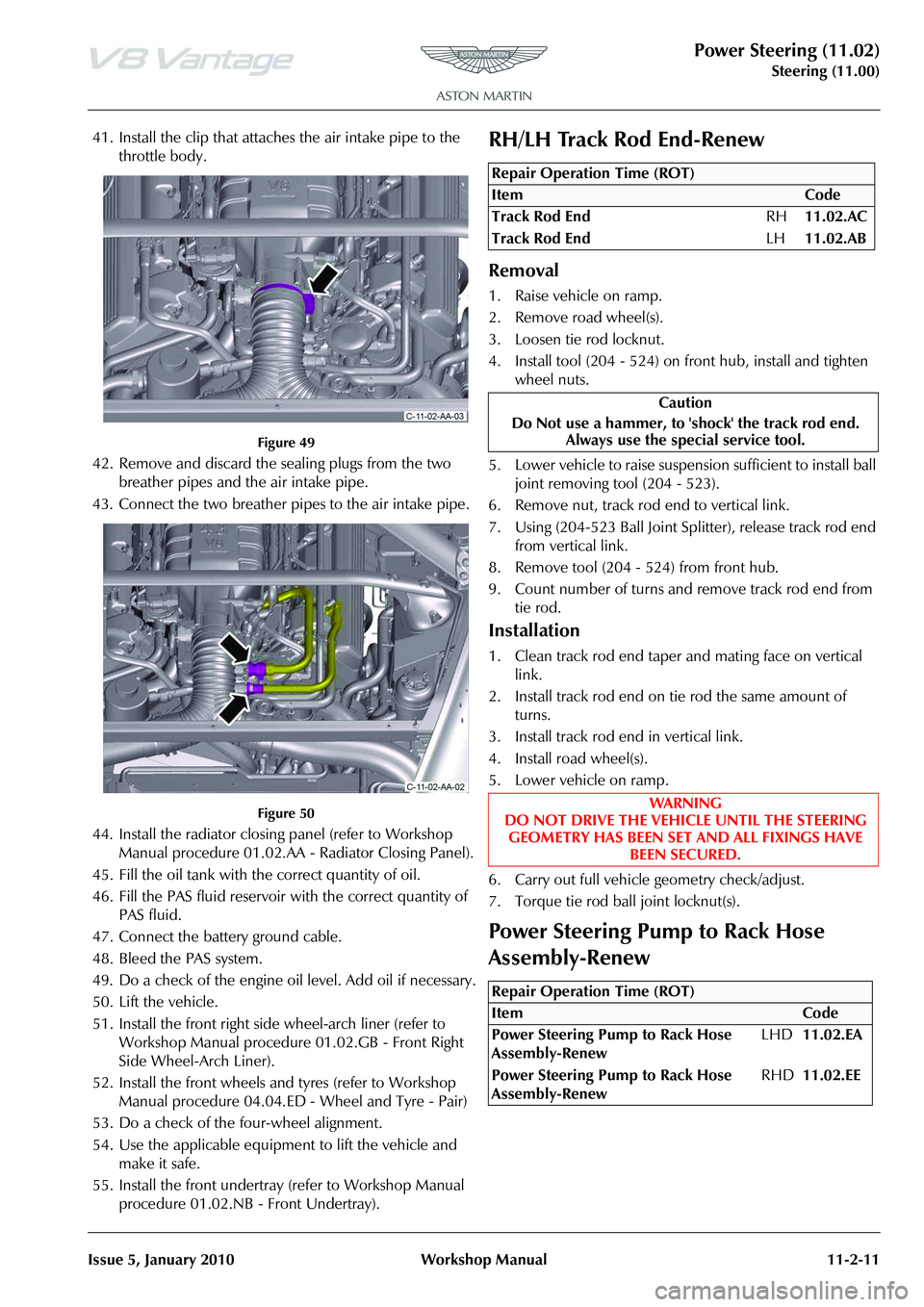
Power Steering (11.02)
Steering (11.00)
Issue 5, January 2010 Workshop Manual 11-2-11
41. Install the clip that attaches the air intake pipe to the throttle body.
Figure 49
42. Remove and discard the sealing plugs from the two breather pipes and the air intake pipe.
43. Connect the two breather pipes to the air intake pipe.
Figure 50
44. Install the radiator closing panel (refer to Workshop Manual procedure 01.02.AA - Radiator Closing Panel).
45. Fill the oil tank with the correct quantity of oil.
46. Fill the PAS fluid reservoir with the correct quantity of
PAS fluid.
47. Connect the battery ground cable.
48. Bleed the PAS system.
49. Do a check of the engine oi l level. Add oil if necessary.
50. Lift the vehicle.
51. Install the front right side wheel-arch liner (refer to Workshop Manual procedure 01.02.GB - Front Right
Side Wheel-Arch Liner).
52. Install the front wheels and tyres (refer to Workshop Manual procedure 04.04.ED - Wheel and Tyre - Pair)
53. Do a check of the four-wheel alignment.
54. Use the applicable equipment to lift the vehicle and make it safe.
55. Install the front undertray (refer to Workshop Manual procedure 01.02.NB - Front Undertray).
RH/LH Track Rod End-Renew
Removal
1. Raise vehicle on ramp.
2. Remove road wheel(s).
3. Loosen tie rod locknut.
4. Install tool (204 - 524) on front hub, install and tighten
wheel nuts.
5. Lower vehicle to raise suspension sufficient to install ball joint removing tool (204 - 523).
6. Remove nut, track rod end to vertical link.
7. Using (204-523 Ball Joint Sp litter), release track rod end
from vertical link.
8. Remove tool (204 - 524) from front hub.
9. Count number of turns and remove track rod end from tie rod.
Installation
1. Clean track rod end taper and mating face on vertical link.
2. Install track rod end on tie rod the same amount of turns.
3. Install track rod end in vertical link.
4. Install road wheel(s).
5. Lower vehicle on ramp.
6. Carry out full vehicle geometry check/adjust.
7. Torque tie rod ball joint locknut(s).
Power Steering Pump to Rack Hose
Assembly-Renew
Repair Operation Time (ROT)
Repair Operation Time (ROT)
Page 615 of 947
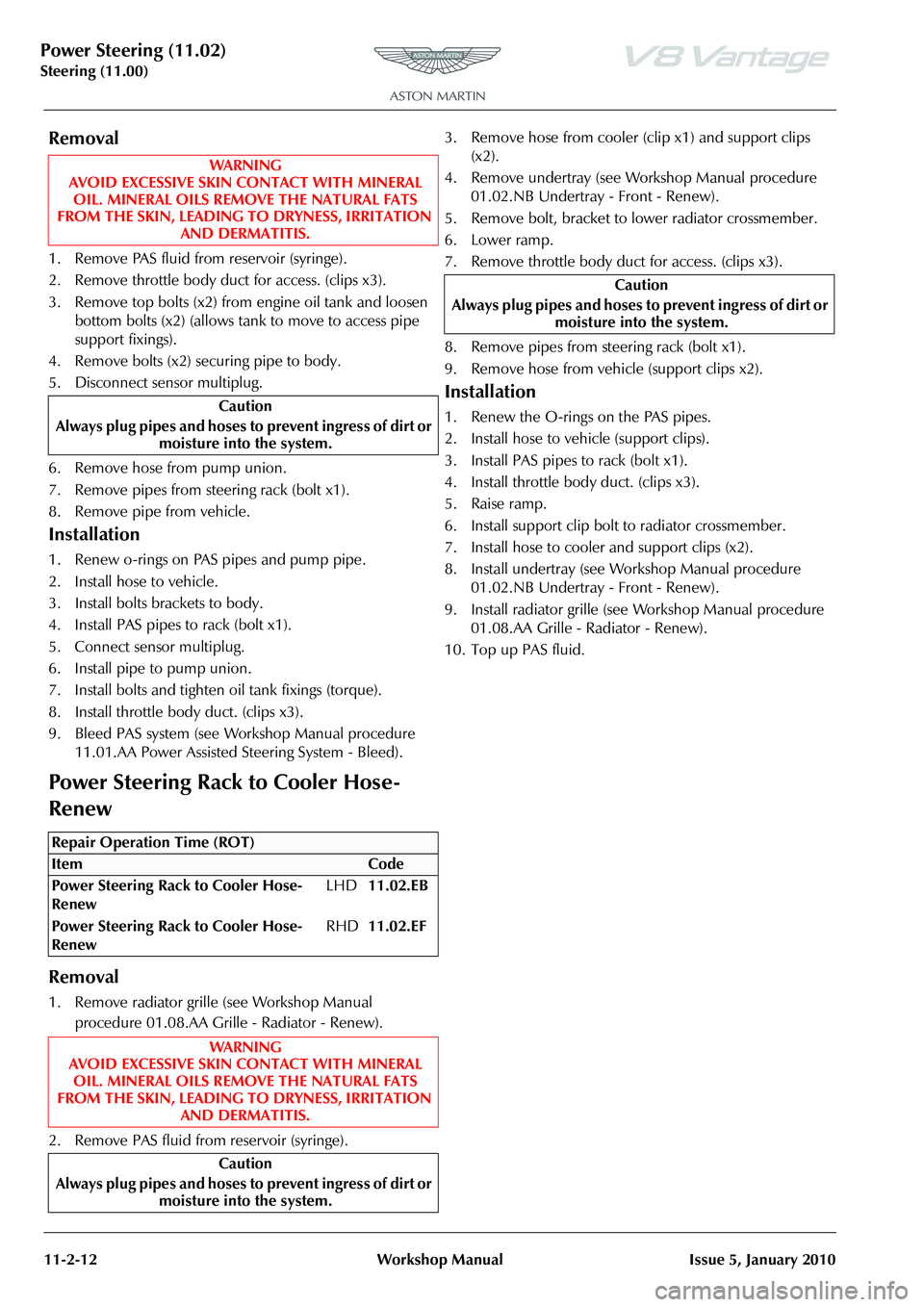
Power Steering (11.02)
Steering (11.00)11-2-12 Workshop Manual Issue 5, January 2010
Removal
1. Remove PAS fluid from reservoir (syringe).
2. Remove throttle body duct for access. (clips x3).
3. Remove top bolts (x2) from engine oil tank and loosen
bottom bolts (x2) (allows ta nk to move to access pipe
support fixings).
4. Remove bolts (x2) securing pipe to body.
5. Disconnect sensor multiplug.
6. Remove hose from pump union.
7. Remove pipes from steering rack (bolt x1).
8. Remove pipe from vehicle.
Installation
1. Renew o-rings on PAS pipes and pump pipe.
2. Install hose to vehicle.
3. Install bolts brackets to body.
4. Install PAS pipes to rack (bolt x1).
5. Connect sensor multiplug.
6. Install pipe to pump union.
7. Install bolts and tighten oil tank fixings (torque).
8. Install throttle body duct. (clips x3).
9. Bleed PAS system (see Workshop Manual procedure 11.01.AA Power Assisted Steering System - Bleed).
Power Steering Rack to Cooler Hose-
Renew
Removal
1. Remove radiator grille (see Workshop Manual
procedure 01.08.AA Grille - Radiator - Renew).
2. Remove PAS fluid from reservoir (syringe). 3. Remove hose from cooler (clip x1) and support clips
(x2).
4. Remove undertray (see Workshop Manual procedure 01.02.NB Undertray - Front - Renew).
5. Remove bolt, bracket to lower radiator crossmember.
6. Lower ramp.
7. Remove throttle body duct for access. (clips x3).
8. Remove pipes from st eering rack (bolt x1).
9. Remove hose from vehicle (support clips x2).
Installation
1. Renew the O-rings on the PAS pipes.
2. Install hose to vehicle (support clips).
3. Install PAS pipes to rack (bolt x1).
4. Install throttle body duct. (clips x3).
5. Raise ramp.
6. Install support clip bolt to radiator crossmember.
7. Install hose to cooler and support clips (x2).
8. Install undertray (see Workshop Manual procedure 01.02.NB Undertray - Front - Renew).
9. Install radiator grille (see Workshop Manual procedure 01.08.AA Grille - Ra diator - Renew).
10. Top up PAS fluid.
WAR NI NG
AVOID EXCESSIVE SKIN CONTACT WITH MINERAL
OIL. MINERAL OILS REMOVE THE NATURAL FATS
FROM THE SKIN, LEADING TO DRYNESS, IRRITATION AND DERMATITIS.
Caution
Always plug pipes and hoses to prevent ingress of dirt or
moisture into the system.
Repair Operation Time (ROT)
Caution
Always plug pipes and hoses to prevent ingress of dirt or moisture into the system.
Page 742 of 947
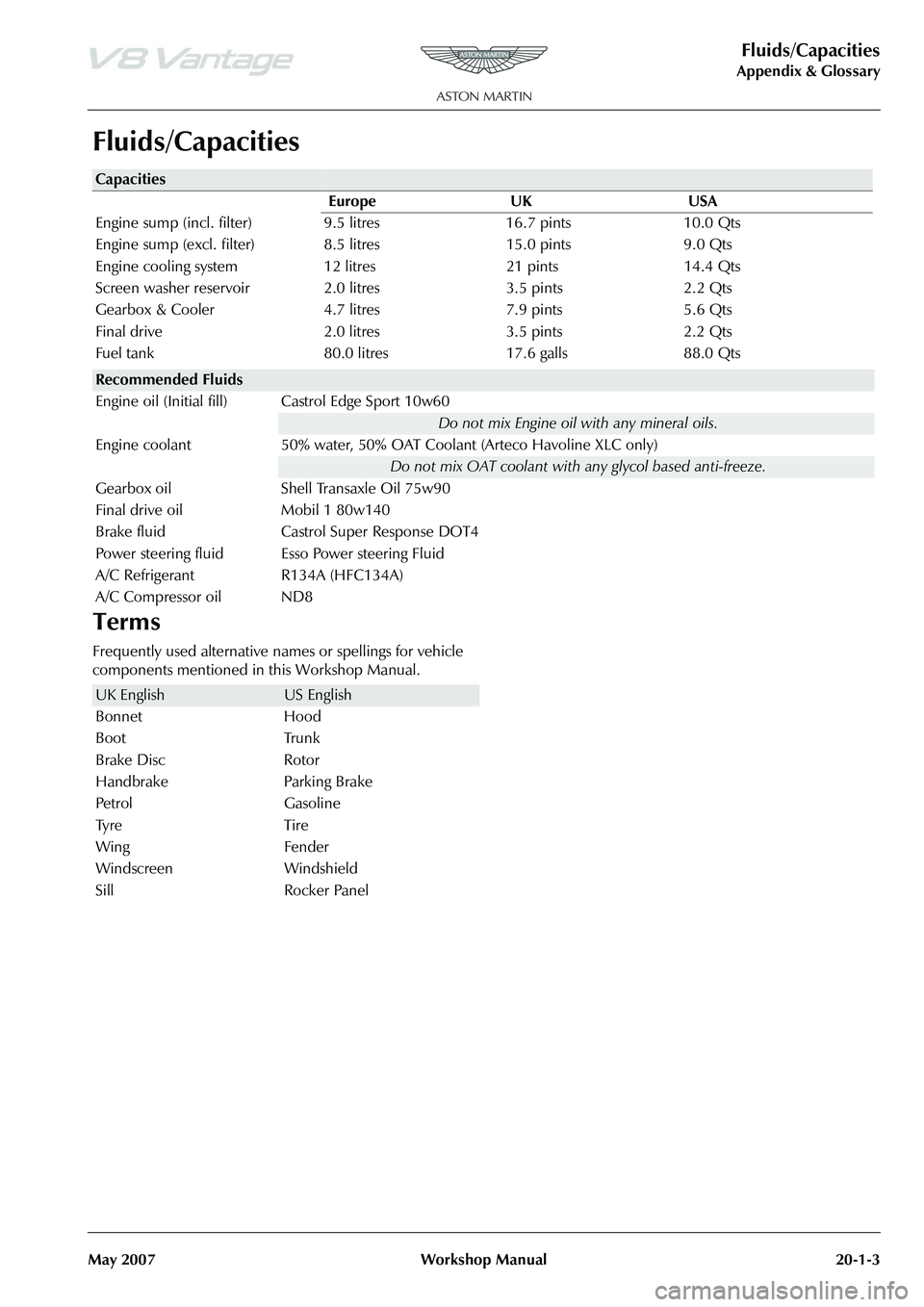
Fluids/Capacities
Appendix & Glossary
May 2007 Workshop Manual 20-1-3
Fluids/Capacities
Terms
Frequently used alternative names or spellings for vehicle
components mentioned in this Workshop Manual.
Capacities
Europe UK USA
Engine sump (incl. filter) 9 .5 litres 16.7 pints 10.0 Qts
Engine sump (excl. filter) 8 .5 litres 15.0 pints 9.0 Qts
Engine cooling system 12 litres 21 pints 14.4 Qts
Screen washer reservoir 2.0 litres 3.5 pints 2.2 Qts
Gearbox & Cooler 4.7 litres 7.9 pints 5.6 Qts
Final drive 2.0 litres 3.5 pints 2.2 Qts
Fuel tank 80.0 litres 17.6 galls 88.0 Qts
Recommended Fluids
Engine oil (Initial fill) Castrol Edge Sport 10w60
Do not mix Engine oil with any mineral oils.
Engine coolant 50% water, 50% OAT Coolant (Arteco Havoline XLC only)
Do not mix OAT coolant with any glycol based anti-freeze.
Gearbox oil Shell Transaxle Oil 75w90
Final drive oil Mobil 1 80w140
Brake fluid Castrol Super Response DOT4
Power steering fluid Esso Power steering Fluid
A/C Refrigerant R134A (HFC134A)
A/C Compressor oil ND8
UK EnglishUS English
Bonnet Hood
Boot Trunk
Brake Disc Rotor
Handbrake Parking Brake
Petrol Gasoline
Tyre Tire
Wing Fender
Windscreen Windshield
Sill Rocker Panel
Page 751 of 947
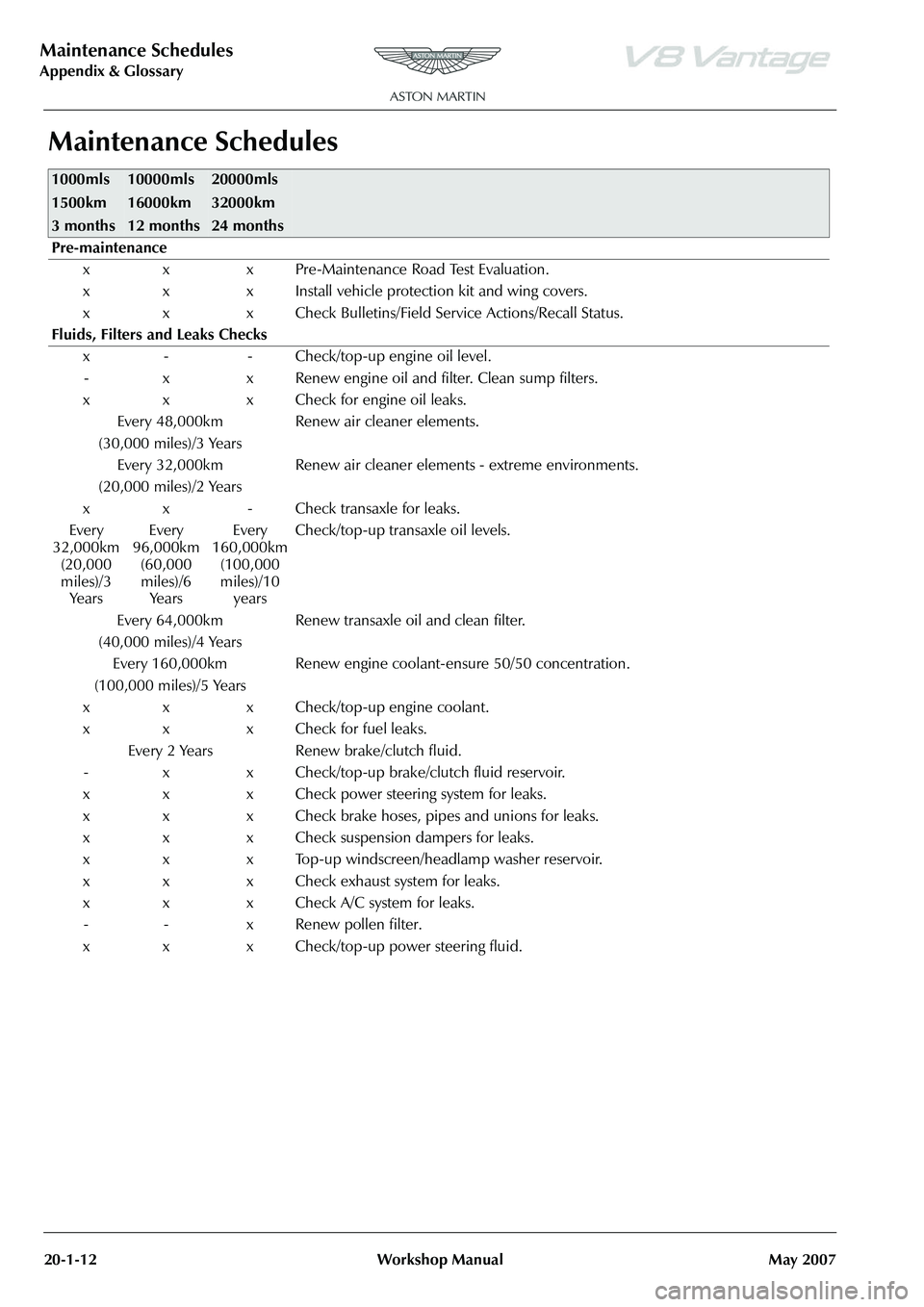
Maintenance Schedules
Appendix & Glossary20-1-12 Workshop Manual May 2007
Maintenance Schedules
1000mls
1500km
3 months10000mls
16000km
12 months20000mls
32000km
24 months
Pre-maintenance
x x x Pre-Maintenance Road Test Evaluation.
x x x Install vehicle protection kit and wing covers.
x x x Check Bulletins/Field Service Actions/Recall Status.
Fluids, Filters and Leaks Checks x - - Check/top-up engine oil level.- x x Renew engine oil and filter. Clean sump filters.
x x x Check for engine oil leaks. Every 48,000km
(30,000 miles)/3 Years Renew air cleaner elements.
Every 32,000km
(20,000 miles)/2 Years Renew air cleaner elements - extreme environments.
x x - Check transaxle for leaks.
Every
32,000km (20,000
miles)/3 Ye a r s Every
96,000km (60,000
miles)/6 Ye a r s Every
160,000km (100,000
miles)/10 years Check/top-up transaxle oil levels.
Every 64,000km
(40,000 miles)/4 Years Renew transaxle oil and clean filter.
Every 160,000km
(100,000 miles)/5 Years Renew engine coolant-ensure 50/50 concentration.
x x x Check/top-up engine coolant.
x x x Check for fuel leaks. Every 2 Years Renew brake/clutch fluid.
- x x Check/top-up brake/clutch fluid reservoir.
x x x Check power steering system for leaks.
x x x Check brake hoses, pipes and unions for leaks.
x x x Check suspension dampers for leaks.
x x x Top-up windscreen/headlamp washer reservoir.
x x x Check exhaust system for leaks.
x x x Check A/C system for leaks. - - x Renew pollen filter.
x x x Check/top-up power steering fluid.